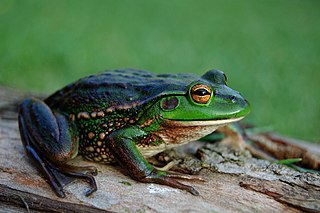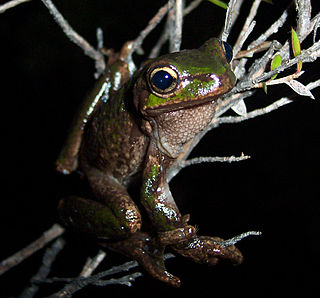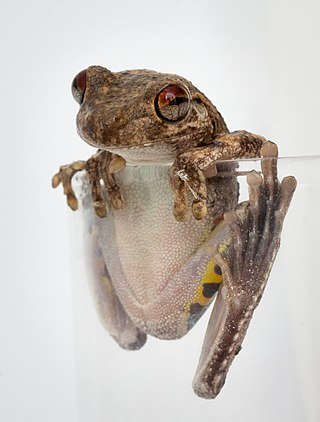
Litoria is a genus of hylid tree frogs, sometimes collectively referred to as Australasian treefrogs.

The eastern dwarf tree frog, also known as the eastern sedge-frog, is a species of tree frog. It is a small and very common frog and found on the eastern coast of Australia, from around Cairns, Queensland, to around Ulladulla, New South Wales. Individual frogs of this species are often found elsewhere, having been accidentally relocated by transported fruit boxes. Confirmed sightings of breeding pairs have confirmed their survival in Victoria's cooler climate.

The Australian green tree frog, also known as simply green tree frog in Australia, White's tree frog, or dumpy tree frog, is a species of tree frog native to Australia and New Guinea, with introduced populations in the United States and New Zealand, though the latter is believed to have died out. It is morphologically similar to some other members of its genus, particularly the magnificent tree frog (R. splendida) and the white-lipped tree frog (R. infrafrenata).

The white-lipped tree frog is a species of frog in the subfamily Pelodryadinae. It is the world's largest tree frog and is found in Australia. Other common names include the New Guinea treefrog, giant tree frog, and Australian giant treefrog.

Tyler's tree frog or the southern laughing tree frog is an arboreal species of tree frog. It is native to eastern Australia where it occurs from south-eastern Queensland to the southern coast of New South Wales. It is generally a coastal species and is not found inland.

The growling grass frog, also commonly known as the southern bell frog, warty swamp frog and erroneously as the green frog, is a species of ground-dwelling tree frog native to southeastern Australia, ranging from southern South Australia along the Murray River though Victoria to New South Wales, with populations through Tasmania. This species' common names vary between states; the name southern bell frog applies in New South Wales and South Australia, growling grass frog in Victoria, and green and gold frog in Tasmania. This species has been introduced to New Zealand.

The Jervis Bay tree frog, also known as the curry frog in reference to its odour, is a species of Australian frog associated with wallum swampland along the east coast of New South Wales; ranging from the Queensland border to eastern Victoria.

The Blue Mountains tree frog also called the variegated river tree frog is a species of tree frog in the subfamily Pelodryadinae. It is endemic to southeastern Australia and is found in eastern Victoria and in southeastern New South Wales. The Jenolan Caves tree frog, a population formerly separated as Litoria jenolanensis, is nowadays included in this species.

The whistling tree frog (Litoria verreauxii), or Verreaux's tree frog, is a species of frog found in Australia. It has been divided into two subspecies, the nominate Verreaux's tree frog and the Verreaux's alpine tree frog. The alpine tree frog is restricted to the southern alps of New South Wales and Victoria. Verreaux's tree frog is widespread throughout south-eastern Queensland, coastal and highland regions of New South Wales, and south-eastern Victoria.

The Tasmanian tree frog, also known as king tree frog, is a species of tree frog that is found on the west coast of Tasmania, Australia. It was first found by Myrtle Burrows in 1941, at Cradle Mountain and handed over to Scott Oswald, who is attributed with the discovery.

The southern brown tree frog, also known as the brown tree frog, whistling tree frog, or Ewing's tree frog, is a species of tree frog native to Australia: most of southern Victoria, eastern South Australia, southern New South Wales from about Ulladulla—although this species is reported to occur further north—and throughout Tasmania including the Bass Strait Islands, in which state it is the most frequently encountered frog. It has been introduced to New Zealand, where it can be locally abundant.

The dainty green tree frog, also known as the graceful tree frog, is a species of tree frog in the subfamily Pelodryadinae. It is native to eastern Queensland, and north-eastern New South Wales, Australia and ranges from northern Cape York in Queensland to Gosford in New South Wales, with a small and most likely introduced population in Hornsby Heights in Sydney. It is one of two faunal emblems of the City of Brisbane.

The green-thighed frog is a species of tree frog in the subfamily Pelodryadinae. Members of this species are medium-sized, ground-dwelling frogs, and are found in Australia.

Roth's tree frog, or the northern laughing tree frog, is a species of tree frog native to northern Australia and southern Papua New Guinea. Roth's tree frog is a common frog, closely related to Peron's tree frog and Tyler's tree frog.

The desert tree frog, or little red tree frog, is a species of tree frog native to Australia, southern New Guinea, and Timor. It is one of Australia's most widely distributed frogs, inhabiting northern Australia, including desert regions and much of temperate eastern Australia. It is one of the few Australian tree frogs to inhabit arid, tropical, and temperate climates.

The orange-thighed frog is a species of tree frog native to a small area of tropical northern Queensland, Australia. It has been observed between 100 and 1500 meters above sea level. It is a green frog with distinctly orange eyes, and is very similar in appearance to the red-eyed tree frog.
Beck's tree frog is a species of frog in the subfamily Pelodryadinae. It is endemic to Papua New Guinea. Its natural habitats are tropical moist montane forests, grasslands and streams. It was first described by the British biologist and herpetologist Arthur Loveridge in 1945 and is named in honour of the American ornithologist and explorer Rollo Beck who led the Whitney South Seas Expedition in the 1920s, collecting bird and other specimens from thousands of islands in the South Pacific.

Davies' tree frog is a species of frog in the subfamily Pelodryadinae. It is endemic to Australia. Its natural habitats are subtropical or tropical dry forests, subtropical or tropical moist lowland forests, subtropical or tropical dry shrubland, and rivers. It is currently threatened by habitat loss.

Ranoidea wilcoxii, also known as the stony-creek frog, eastern stony creek frog, and Wilcox's frog, is a species of frog in the subfamily Pelodryadinae. It is endemic to Australia, being found solely on the eastern coast between Ingham, QLD, and Sydney, NSW, and as far west as Atherton, QLD. Its natural habitats are subtropical or tropical dry forests, subtropical or tropical moist lowland forests, rivers, intermittent rivers, and pastureland.
Litoria spartacus is a species of frog in the subfamily Pelodryadinae of the family Hylidae. It is endemic to Papua New Guinea and is only known from two localities within the Kikori Integrate Conservation and Development Project Area in the Southern Highlands Province. It has affinities to Litoria macki and Litoria spinifera but has a smaller size and more extensively webbed hands and less tuberculate body.




















